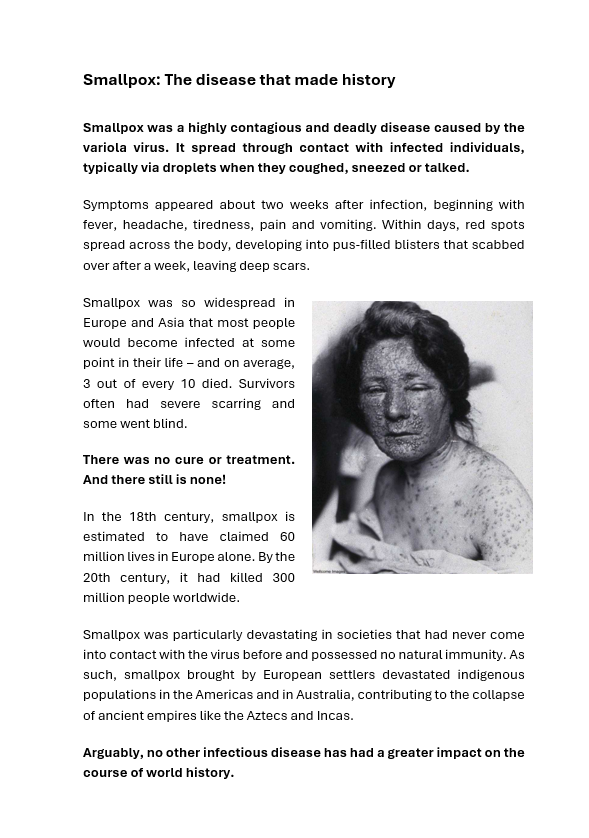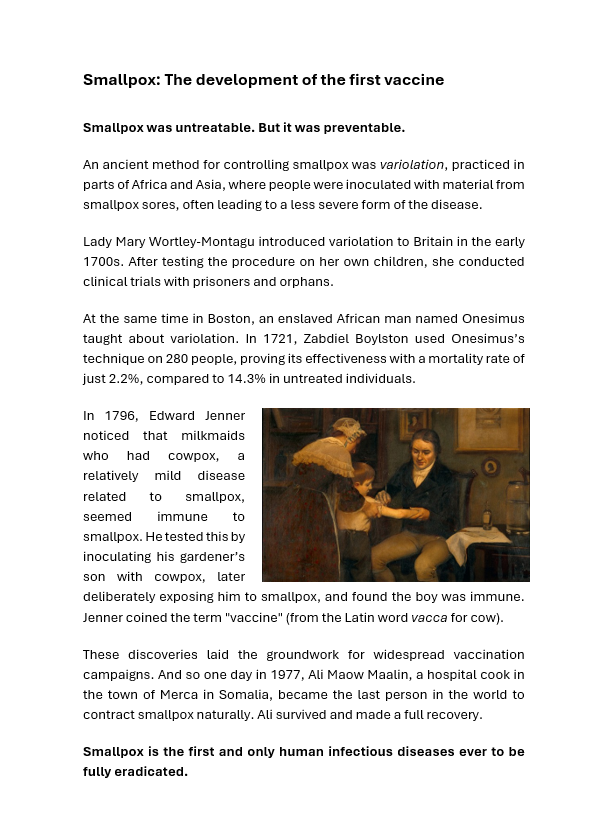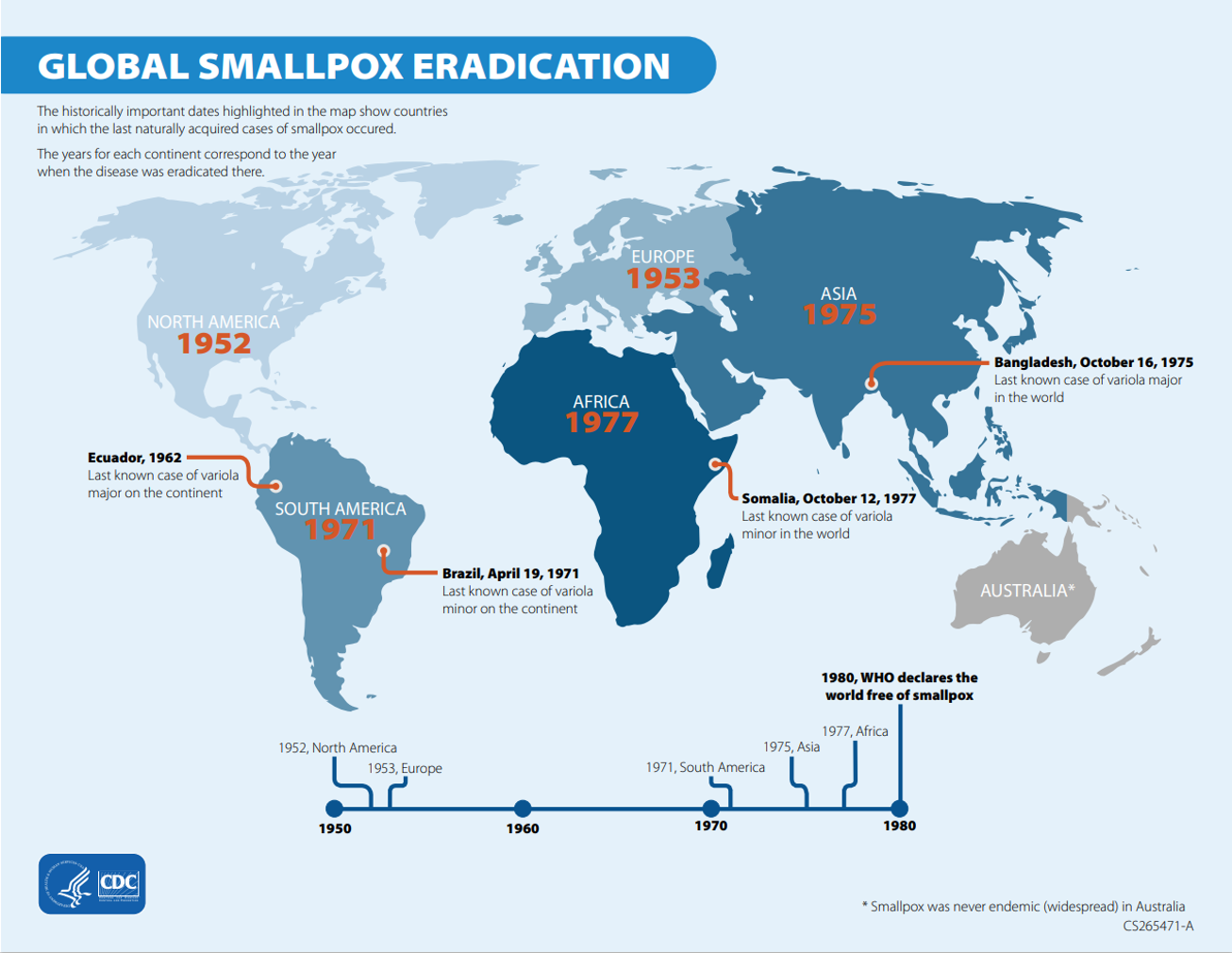
Horror Show – Smallpox
The disease that made history
Smallpox was a highly contagious and deadly disease caused by the variola virus. It spread through contact with infected individuals, typically via droplets when they coughed, sneezed or talked.
The display featured an inflatable globe labelled with the words “smallpox is dead” across, thus recreating the iconic front title of the WHO magazine from May 1980.
Posters provided information about the disease in general, a summary of the history of the smallpox vaccine, a map illustrating when smallpox was eradicated in different parts of the world, and a photo of Ali Maow Maalin - the last person ever to contract natural smallpox.
The display also featured several copies of a story about Edward Jenner’s work on the smallpox vaccine written as part of an inter-school competition, for visitors to take home.
Materials to download, in English and Welsh:
➡️ Story Time: Smallpox - The Disease That Made History
Symptoms appeared about two weeks after infection, beginning with fever, headache, tiredness, pain and vomiting. Within days, red spots spread across the body, developing into pus-filled blisters that scabbed over after a week, leaving deep scars.
The origin of smallpox is unknown.
The earliest evidence for the disease comes from the Egyptian Pharaoh Ramses V, who died in 1157 B.C. and whose mummified remains show smallpox-like rashes on the skin.
Smallpox was so widespread in Europe and Asia that most people would become infected at some point in their life – and on average, 3 out of every 10 died. Survivors often had severe scarring and some went blind.
There was no cure or treatment. And there still is none!
In the 18th century, smallpox is estimated to have claimed 60 million lives in Europe alone. By the 20th century, it had killed 300 million people worldwide.
Smallpox was particularly devastating in societies that had never come into contact with the virus before and possessed no natural immunity. As such, smallpox brought by European settlers devastated indigenous populations in the Americas and in Australia, contributing to the collapse of ancient empires like the Aztecs and Incas.
Arguably, no other infectious disease has had a greater impact on the course of world history
The development of the first vaccine
Smallpox was untreatable. But it was preventable.
An ancient method for controlling smallpox was variolation, practiced in parts of Africa and Asia, where people were inoculated with material from smallpox sores, often leading to a less severe form of the disease.
Lady Mary Wortley-Montagu introduced variolation to Britain in the early 1700s. After testing the procedure on her own children, she conducted clinical trials with prisoners and orphans.
At the same time in Boston, an enslaved African man named Onesimus taught about variolation. In 1721, Zabdiel Boylston used Onesimus’s technique on 280 people, proving its effectiveness with a mortality rate of just 2.2%, compared to 14.3% in untreated individuals.
In 1796, Edward Jenner noticed that milkmaids who had cowpox, a relatively mild disease related to smallpox, seemed immune to smallpox. He tested this by inoculating his gardener’s son with cowpox, later deliberately exposing him to smallpox, and found the boy was immune. Jenner coined the term "vaccine" (from the Latin word vacca for cow).
These discoveries laid the groundwork for widespread vaccination campaigns. And so one day in 1977, Ali Maow Maalin, a hospital cook in the town of Merca in Somalia, became the last person in the world to contract smallpox naturally. Ali survived and made a full recovery.
Smallpox is the first and only human infectious diseases ever to be fully eradicated.
➡️ Horror Show
Return to the Horror Show starting page
➡️ Pop-Up Shop 2025
Go to the main event page of our 2025 Pop-Up Shop









